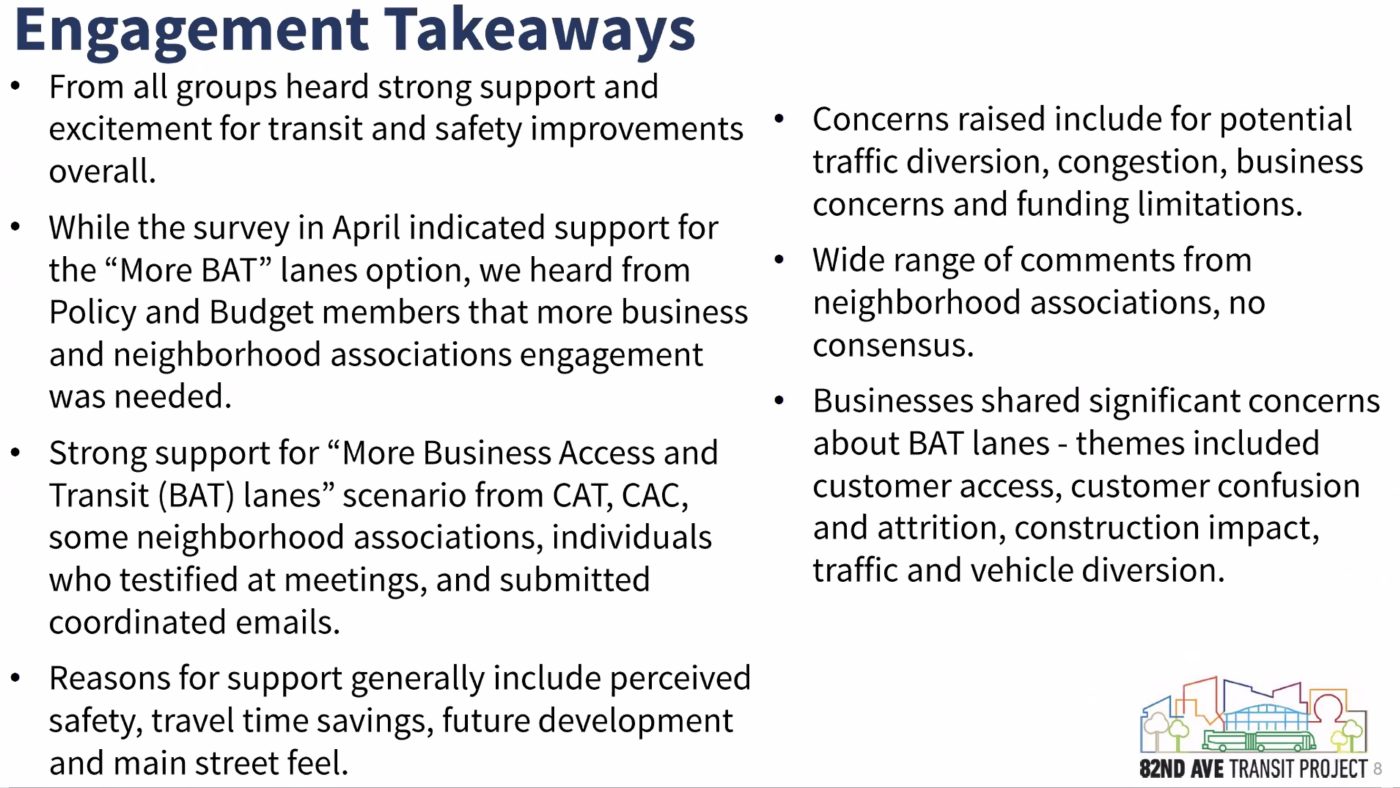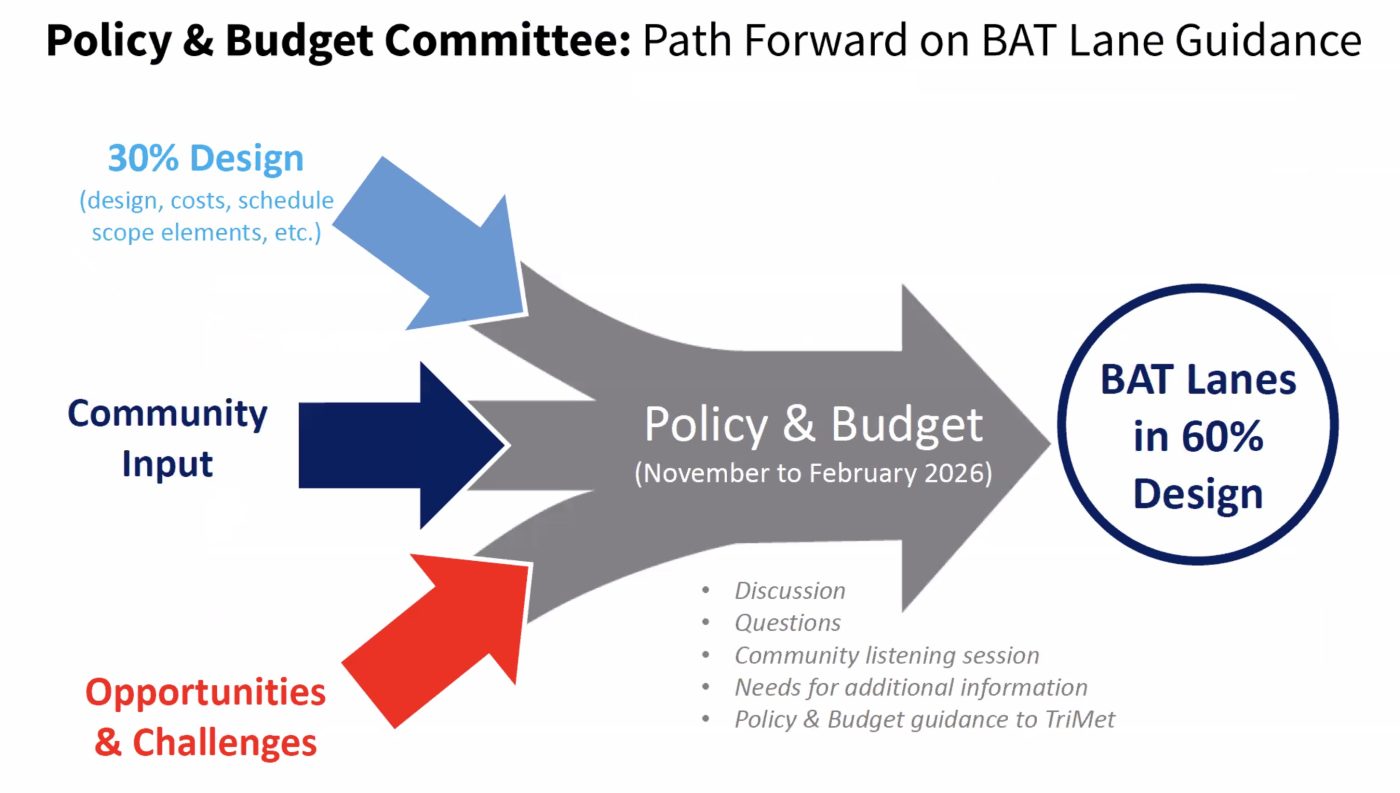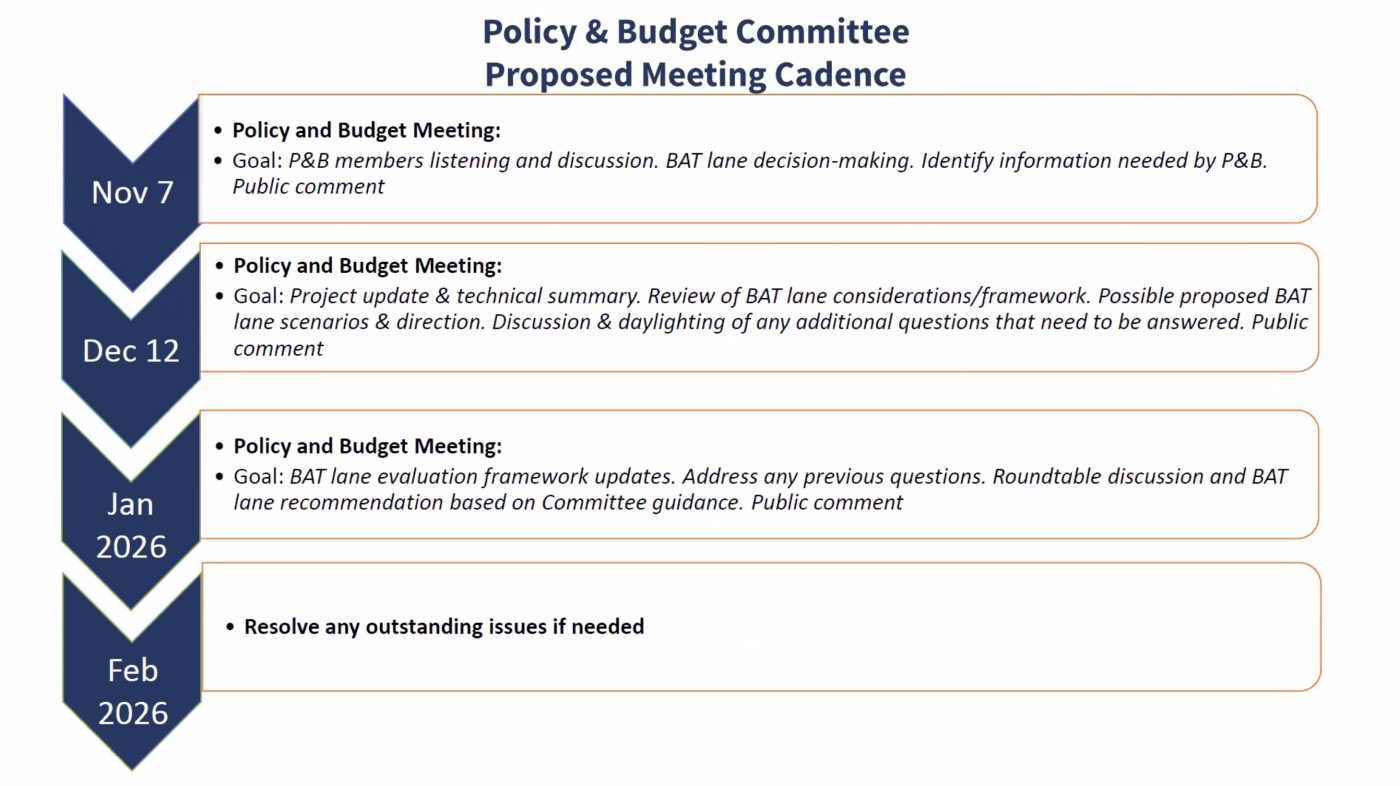The dream of steady, semi-dedicated bus lanes on 82nd Avenue is alive; however whether it is to turn out to be a actuality, somebody moreover our regional transit company must step up and make it occur. That’s the place made clear by TriMet Common Supervisor Sam Desue and the company’s Interim Director of Main Tasks Michael Kiser at a gathering this morning.
The excellent news from the assembly is that Metro and the Portland Bureau of Transportation seem able to step up.
At challenge is what number of miles of “enterprise entry and transit” (BAT) lanes needs to be constructed as a part of the $350 million 82nd Avenue Transit Venture. The 2 choices underneath dialogue are: “Some BAT,” which might construct simply three miles of bus lanes and depart busiest, central portion of the venture hall with customary lanes the place buses are caught behind vehicles; and “Extra BAT, which might value $8 million extra and construct seven steady miles of bus lanes from SE Clatsop on the Multnomah/Clackamas county line to NE Lombard Avenue within the Cully neighborhood.
TriMet brought on a stir final month after they launched a employees suggestion memo choosing “Some BAT.” They’ve since walked again that suggestion, however after this morning’s assembly we now have a clearer understanding of why our transit company is selecting the choice with much less transit: In line with Desue and Kiser, a costlier and bold venture might jeopardize the price range and timeline. With federal funding, there will be no diversion from the timeline and TriMet desires to take the most secure possibility.
On the outset of the venture’s Coverage and Price range Committee assembly this morning, Desue stated he’s conscious the group is, “advocating for a daring imaginative and prescient for 82nd Avenue.” However, he added, “For these of you who know building, scope is greater than only a phrase, it’s our basis.”
“Scope defines what we’ll construct, how we’ll construct it, and it serves our promise to ship on that imaginative and prescient,” he continued. “To maintain that promise, we’d like a price range that matches the scope and a timeline for supply. Any changes to the scope, schedule or price range make venture supply tougher. In order that’s why our route to the venture crew is all the time: scope a venture that we will construct.”
Desue then referred to the bus lane choice as one TriMet “can’t make alone due to the influence on scope, schedule and price range,” and that, “the venture has its limits, however our investments will be leveragd by the great work you all do” (the place the “you” referred to venture companions at Metro, the Portland Bureau of Transportation and the Oregon Division of Transportation).
Kiser has echoed this sentiment. He maintains that the employees suggestion for “Some BAT” displays the truth of what TriMet can ship by themselves. In reference to the advice at this morning’s assembly he stated it, “Didn’t essentially match the aspirational expectations of some companions, and in addition people locally as properly.”




The excellent news is that TriMet is giving extra time for this challenge to be debated earlier than a closing choice (anticipated by February 2026) might be made.
Metro Councilor and Coverage and Price range Committee member Duncan Hwang, who was one of many individuals caught off-guard by TriMet’s preliminary employees suggestion, urged people to not accept compromised transit. He sees higher transit as important to the way forward for 82nd Avenue, particularly as improvement hastens within the close to future. “With the brand new 82nd Avenue TIF [tax increment financing] district, 40% of that [revenue] goes to inexpensive housing — so that you’re going to see 30 extra buildings alongside the hall over over the approaching decade or two,” Hwang stated.
“So how can we create one of the best transit system to help that new imaginative and prescient that’s coming?…I feel that requires us to be formidable at this second,” he added.
Hwang made it clear he’s able to advocate for extra funding from Metro if that’s what it takes. “Deliver us that price range,” he stated. “We wish the hall of our goals, and I don’t need to reduce issues off earlier than we’ve had that full dialog.”
PBOT Director Millicent Williams additionally sounded prepared to seek out more cash to construct steady bus lanes. “Sure that might be costlier,” she stated. “However that’s what we’re right here to do, to assist elevate cash.” Williams additionally identified that the additional $8-10 million wanted for the “Extra BAT” possibility, “shouldn’t be some huge cash.” “We are able to determine easy methods to elevate $10 million if it’s a $350 million funding.”
Williams sees this not simply as a query of {dollars} and cents, however as a logo of what Portland stands for. “The problem actually is: What are we saying as a area? What’s the coverage assertion that we’re making by the alternatives that we’re placing ahead? It’s much less concerning the cash, and extra about what are we saying concerning the group that has been traditionally underserved and underinvested in, and the way are we assembly this second?”
TriMet continues to be gathering suggestions from companies alongside 82nd concerning the bus lanes and plans to current a full group engagement report on the December twelfth Coverage and Price range Committee assembly. Additionally at that assembly TriMet and ODOT will share extra particulars about diversion evaluation and different technical metrics that might affect the choice. An ODOT rep on the committee identified that ODOT has to challenge a allow to PBOT as a result of the lane choice will influence two state highways that intersect with 82nd: US 30 (NE Lombard) and US 26 (SE Powell).
The subsequent assembly for this venture is a Group Advisory Committee assembly on November nineteenth. Study extra on the venture web site.































